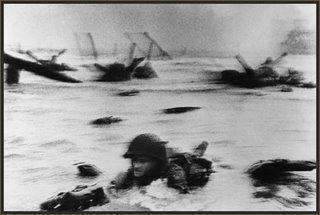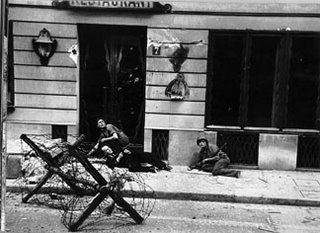The War Photographs of Robert Capa

(Click here for the Romanian version)
June 6, 1944, D-Day Landing. Eleven photographs shot there, on Omaha Beach. Robert Capa was there as a war photographer, among the soldiers of the 16th Regiment of the 1st Infantry Division.
The war correspondent has his stake — his life — in his own hands, and he can put it on this horse or that horse, or he can put it back in his pocket at the very last minute ... I am a gambler. I decided to go in with Company E in the first wave (Robert Capa).
Today we name them embedded correspondents. He took part as an embedded correspondent in all major battles of his epoch.
 Only eleven photos survived - Capa had taken 108 pictures in the first couple of hours of the invasion. Later, someone would made a mistake in the darkroom - only eleven frames in total were recovered. They remained known as the Magnificent Eleven of the D-Day.
Only eleven photos survived - Capa had taken 108 pictures in the first couple of hours of the invasion. Later, someone would made a mistake in the darkroom - only eleven frames in total were recovered. They remained known as the Magnificent Eleven of the D-Day.
This image is from Paris, August 25, 1944. The day Paris became free again, after years of Nazi occupation. Capa was there, embedded within the American troops.
He was again in Paris - the city of his second birth. His real name was Endre Friedmann. He left his native country, Hungary, when he was barely 20 and settled firstly in Berlin, where he discovered his passion for photography. With the arise of Hitler at power he was forced to leave Germany. He came to Paris. Here he met Cartier-Bresson and David Seymour (Chim) - the three would remain life friends - later, after the World War II, they would start the Magnum Photos. Capa would settle later in New York, but Paris remained the city of his heart.
He met in Paris his first great love, Gerda. She persuaded him to adopt a new name, as she was devising for them a very careful marketing approach - so the Endre Friedmann became Robert Capa. Gerda would die in the Civil War in Spain, she was there a war correspondent.
 Was Robert Capa a Communist? Well, I think, in his youth he was far too radical to be a Communist. In his adult years he became too rich and famous. And he was far too independent. He never could be other than a man of his own. A Leftist, yes, he was all his life. In 1932 he made several photos of Trotzki - who was for a brief period in Copenhagen.
Was Robert Capa a Communist? Well, I think, in his youth he was far too radical to be a Communist. In his adult years he became too rich and famous. And he was far too independent. He never could be other than a man of his own. A Leftist, yes, he was all his life. In 1932 he made several photos of Trotzki - who was for a brief period in Copenhagen.Perhaps the most famous photo shot by Capa is this one, Death of a Loyalist Militiaman in the Spanish Civil War. It surprises the very moment the militiaman is killed. It's like a premonition - Capa would die in the First Indochina War, in 1954. He was with a French unit, they were passing a dangerous area - suddenly Capa jumped out of the jeep and ran ahead, to photograph the advance - he stepped on a landmine.
If your pictures aren't good enough, you're not close enough
(Robert Capa)

Labels: Robert Capa

0 Comments:
Post a Comment
<< Home